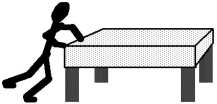A) 20 m/s with a direction that's impossible to predict without more information.
B) also northward at 20 m/s.
C) zero.
D) southward at 20 m/s.
E) impossible to predict without more information.
Correct Answer

verified
Correct Answer
verified
Multiple Choice
Which of the following principles explains why guns recoil?
A) The law of inertia.
B) Conservation of momentum.
C) Newton's law of motion.
D) Conservation of energy.
E) None of the above.
Correct Answer

verified
Correct Answer
verified
Multiple Choice
A rocket taking off straight upward develops a thrust of 10,000 newtons. The rocket weighs 2,000 newtons. The net force on the rocket, neglecting air resistance, is
A) 8,000 newtons.
B) 10,000 newtons.
C) 12, 000 newtons.
D) 2,000 newtons.
E) zero.
Correct Answer

verified
Correct Answer
verified
Multiple Choice
Suppose we subject a golf ball and a more massive lead ball to identical net forces. Then, compared to the golf ball, the lead ball must have
A) a larger acceleration.
B) a smaller acceleration.
C) a larger speed.
D) a smaller speed.
E) None of the above answers is necessarily true.
Correct Answer

verified
Correct Answer
verified
Multiple Choice
The basic physical principal principle that explains the operation of rocket engines is
A) the law of force pairs.
B) the law of inertia.
C) the atomic hypothesis.
D) Galileo's principle of falling.
E) Actually, rockets are unexplainable.
Correct Answer

verified
Correct Answer
verified
Multiple Choice
A certain grapefruit on Earth has a mass of one kilogram and a weight of one newton. When the grapefruit is on the moon its mass is
A) one kilogram.
B) less than ten newtons.
C) ten newtons.
D) less than one kilogram.
Correct Answer

verified
Correct Answer
verified
Multiple Choice
 Mary pushes horizontally on a large, heavy table which is standing alone in the middle of a room, and notes that the table does not move despite the fact that she is pushing on it (see the figure) . Why doesn't the table move?
Mary pushes horizontally on a large, heavy table which is standing alone in the middle of a room, and notes that the table does not move despite the fact that she is pushing on it (see the figure) . Why doesn't the table move?
A) Very massive objects, such as the table, are difficult to set into motion because of their large inertia.
B) The table pushes back on Mary with a force that is even larger than Mary's pushing force.
C) The force of gravity pulls downward on the table, and this force cancels the pushing force.
D) A frictional force is also exerted by the floor on the table, and this force is equal and opposite to the pushing force.
E) The table exerts a force on Mary, and this force is equal and opposite to the pushing force.
Correct Answer

verified
Correct Answer
verified
Multiple Choice
Are there any kinds of situations in which the momentum of a moving system is not conserved?
A) No, because the momentum of any system is always conserved.
B) Yes, if there is friction acting between different parts of the system.
C) Yes, if some of the parts of the system collide with each other.
D) Yes, if any part of the system is acted upon by forces external to the system.
E) No, because the law of inertia demands that any moving system must keep moving.
Correct Answer

verified
Correct Answer
verified
Multiple Choice
One- third as much net force is exerted on object A as on object B. The two objects have the same mass. How do their accelerations compare?
A) Object A has three times as much acceleration as object B.
B) Object A has one- sixth as much acceleration as object B.
C) Object A has one- third as much acceleration as object B.
D) They both have the same acceleration.
E) It is impossible to answer this without further information about the two objects.
Correct Answer

verified
Correct Answer
verified
Multiple Choice
You throw a ball straight upward. While it is moving upward, the net force on the ball is
A) zero.
B) in the downward direction.
C) in the horizontal direction.
D) in the upward direction.
E) directed oppositely to the acceleration.
Correct Answer

verified
Correct Answer
verified
Multiple Choice
A block of wood is given a brief push and then allowed to slide [without further pushing] along a table top, slowing down as it moves toward the east. As the block slides,
A) its acceleration is toward the east.
B) its acceleration is toward the west.
C) the net force on it is zero.
D) it has no acceleration.
E) its velocity is toward the west.
Correct Answer

verified
Correct Answer
verified
Multiple Choice
You hold a 5- newton rock motionless in your hand. Regarding the forces on this rock,
A) there are no forces of any kind acting on the rock, because it is not moving.
B) the downward force of gravity is balanced by the upward force of air resistance.
C) the net force on the rock is 5 newtons, directed upward.
D) the net force on the rock is 5 newtons, directed downward.
E) the net force on the rock is zero.
Correct Answer

verified
Correct Answer
verified
Showing 61 - 72 of 72
Related Exams